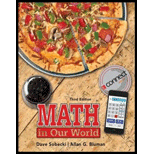
Concept explainers
(a) We know that when flipping a coin, the probability of getting tails is 1/2. Use a tree diagram to find the probability of getting tails twice in a row.
(b) We also know that the probability of rolling a 5 with one die is 1/6. Use tree diagrams to find the probability of getting tails and then rolling a 5 when you flip a coin and then roll a single die.
(c) Based on the results of parts (a) and (b), how do you think you find the probability of two unconnected events occurring consecutively when you know the probability of each occurring individually? (Answer successfully, and you’ve discovered an important rule we’ll study in Section 11-8.)
Want to see the full answer?
Check out a sample textbook solution
Chapter 11 Solutions
Math in Our World
Additional Math Textbook Solutions
Pathways To Math Literacy (looseleaf)
Elementary Statistics ( 3rd International Edition ) Isbn:9781260092561
Intermediate Algebra (13th Edition)
Elementary Statistics Using The Ti-83/84 Plus Calculator, Books A La Carte Edition (5th Edition)
Introductory Statistics
Elementary Statistics: Picturing the World (7th Edition)
- 3) Find an equation for the parabola with a vertex at (1, 2) and focus at (1, 4). A) (x - 1)² = 8(y-2) C) (x - 1)² = -8(y - 2) B) (y - 2)² = -12(x − 1) - D) (y - 2)² = 12(x-1)arrow_forward2) Graph the equation. y² = 12x 5 10 -10 -5 5 + 10 xarrow_forward15) Solve the triangles if possible. B = 11°, b = 15.5, a = 40.62arrow_forward
- 10) Find the exact value of the expression. tan−1 [tan (~ 7}]] 8arrow_forward12) The point (-15, -8) is on the terminal side of an angle in standard position. Determine the exact values of the three trigonometric functions sine, cosine, and tangent of the angle 0.arrow_forwardFind the critical value for a left-tailed test using the F distribution with a 0.025, degrees of freedom in the numerator=12, and degrees of freedom in the denominator = 50. A portion of the table of critical values of the F-distribution is provided. Click the icon to view the partial table of critical values of the F-distribution. What is the critical value? (Round to two decimal places as needed.)arrow_forward
- 6) Find the center, foci, and vertices of the ellipse. = 9 49 1arrow_forward1) Find an equation of the parabola with a focus at (0, 4) and directrix the line y = -4, and state the two points that define the latus rectum. A) x² = 16y; latus rectum: (4, 8) and (-4,8) B) x² = 4y; latus rectum: (2, 4) and (-2, 4) C) x² = 16y; latus rectum: (8, 4) and (-8, 4) D) y² = 4x; latus rectum: (9, 2) and (-9, 2)arrow_forward4) A spotlight has a parabolic cross section that is 6 ft wide at the opening and 2.5 ft deep at the vertex. How far from the vertex is the focus? Round answer to two decimal places. A) 0.90 ft B) 0.21 ft C) 0.52 ft D) 0.26 ftarrow_forward
 College Algebra (MindTap Course List)AlgebraISBN:9781305652231Author:R. David Gustafson, Jeff HughesPublisher:Cengage Learning
College Algebra (MindTap Course List)AlgebraISBN:9781305652231Author:R. David Gustafson, Jeff HughesPublisher:Cengage Learning Holt Mcdougal Larson Pre-algebra: Student Edition...AlgebraISBN:9780547587776Author:HOLT MCDOUGALPublisher:HOLT MCDOUGALAlgebra & Trigonometry with Analytic GeometryAlgebraISBN:9781133382119Author:SwokowskiPublisher:Cengage
Holt Mcdougal Larson Pre-algebra: Student Edition...AlgebraISBN:9780547587776Author:HOLT MCDOUGALPublisher:HOLT MCDOUGALAlgebra & Trigonometry with Analytic GeometryAlgebraISBN:9781133382119Author:SwokowskiPublisher:Cengage
 College AlgebraAlgebraISBN:9781305115545Author:James Stewart, Lothar Redlin, Saleem WatsonPublisher:Cengage Learning
College AlgebraAlgebraISBN:9781305115545Author:James Stewart, Lothar Redlin, Saleem WatsonPublisher:Cengage Learning




